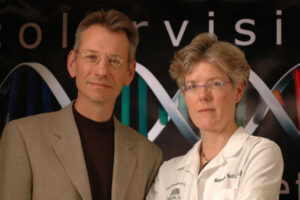As we move deeper into fall and the hours of daylight dwindle, a trio of researchers from the same family has worked together to create new technology that helps humans improve our health and our moods by managing our circadian rhythms. And they say we can thank research monkeys for it.
 In new research from professors Jay and Maureen Neitz of the UW Department of Ophthalmology, and their youngest daughter Alex (who was a graduate research assistant at UW and is now a postdoctoral researcher at the University of California San Diego) helped show that, an LED light that emits alternating wavelengths of orange and blue light helped boost melatonin levels in a group of study participants, shifting their “internal clocks” to align how our body’s supposed to act during different times of day.
In new research from professors Jay and Maureen Neitz of the UW Department of Ophthalmology, and their youngest daughter Alex (who was a graduate research assistant at UW and is now a postdoctoral researcher at the University of California San Diego) helped show that, an LED light that emits alternating wavelengths of orange and blue light helped boost melatonin levels in a group of study participants, shifting their “internal clocks” to align how our body’s supposed to act during different times of day.
The findings, published in the Journal of Biological Rhythms, show that the alternating wavelengths can influence circadian rhythms, an effective approach to counteract seasonal affective disorder (SAD), among other maladies.
A host of health and mood problems are attributed to out-of-sync circadian rhythms, Jay Neitz says. The result is “social jet lag” that occurs during seasonal changes and a lack of exposure to natural light, not to mention night jobs and international travel.
“In extreme cases what this being not synchronized has been linked to diabetes and cancer and all sorts of problems,” he said. “At the very least, people just aren’t at their best. They don’t feel great because their internal clock isn’t set right. Theirs’s huge interest in this kind of thing.”
The Neitzes designed an experiment using light that alternated between short- and long-wavelength components that advanced the circadian phase by an average of almost an hour and a half.
 And it’s led to the development of products that produce these alternating blue/orange wavelengths. Called “TUO Circadian Smart Products,” the line consists of an LED lightbulb and various lamps, which can be managed by a smartphone app.
And it’s led to the development of products that produce these alternating blue/orange wavelengths. Called “TUO Circadian Smart Products,” the line consists of an LED lightbulb and various lamps, which can be managed by a smartphone app.
All this from the trio who mesh work and life and always have.
“There’s a lot of talk about work life balance,” said Jay. “Our work and lives have just been one thing. We work all the time, and we have two daughters. Our younger daughter, Alex, started working in our lab as a child.”
“It wasn’t like this started in grad school it was a gradual process,” Alex said. “In grad school I was interested in circadian rhythms, and I went to grad school immediately after undergrad.”
Like mother, like daughter. Maureen and Alex are both molecular biologists who wound up interested in studying vision and the nonhuman primate model.
Jay credits NHP research stemming from a grant that helped Maureen obtain an electron microscope that enabled researchers to build a complete look at the retina that was the foundation for research that led to the Tho light. So none of it would have happened without NHP research.
“There are things about the way our eyes work and how they communicate with the central parts of our brain that are unique to primates,” Jay said, recalling contributions of WaNPRC’s Tissue Distribution Program. “Because of that we got preservation of microdetails of all cells in the retina that could never be gotten from a human. We believe what we’re seeing in the NHP model is exactly like what happens in a human. There’s just no other example like this.”